Spider-view: "Sabotage"
Todd McFarlane's time on Spider-Man ends disappointingly, an action-packed crossover with not enough story to keep it moving
—by Nathan on May 14, 2023—
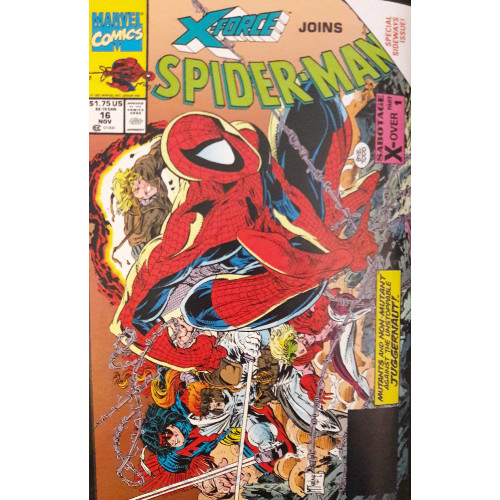
We have…“trawled” may be the right word…trawled our way through Todd McFarlane’s run on the non-adjective Spider-Man series (or what I and others have referred to as the "Adjectiveless Spider-Man," amusingly giving it the descriptor it has often lacked). Or “crawled.” More spider-like. Either “awl” word we use implies a slow, largely methodical sifting through of story, much like a fishing trawler scrounges up fish or a crocodile crawls towards unsuspecting prey. Each movement slow, sometimes painstakingly slow…and the net has often come up empty, the prey bounds away before we can latch our jaws around its hind legs.
McFarlane’s series has been a bit like that, leaping away, avoiding easy discernment and analysis. I have wanted to like this series. I really have. I was excited when I purchased the Complete Collection housing the 14 issues I have plodded through so far. I had heard a bit about the series, I was familiar with McFarlane’s work, I knew the first issue (the inaugural chapter in McFarlane’s “Torment” arc) sold a bajillion copies. I expected something…different. Better. A bit more substantial than average comic book fare and, perhaps unfairly, something better than what we ended up receiving. I was hoping to give a double thumbs-up. “Great art, great stories.” But, sadly, that has not been the case. Yes, the art’s been great, gorgeously detailed. Cities, sewers, forests…all come to life under McFarlane’s capable environmental design. And the characters–I’m a fan of McFarlane’s highly detailed Spidey, his animalistic Lizard, his ferocious Wendigo, even his varied, unfortunately misshapen Subhumans. But the stories…as noted elsewhere, McFarlane’s talents are highlighted when his pen draws characters from lines, not words.
We have one more story to “trawl” through together, McFarlane’s final issue. It’s a two-part tale, the Spider-Man issue lumped in with an issue of X-Force. I’ll say it right now: it isn’t the spidery swan song I would have hoped for.
“Sabotage”
Writers: Todd McFarlane, Rob Liefeld, Fabian Nicieza
Pencilers: Todd McFarlane, Rob Liefeld
Inkers: Todd McFarlane, Rob Liefeld
Colorists: Greg Wright, Brian Murray
Letterers: Chris Eliopoulos, Joe Rosen
Issues: Spider-Man #16, X-Force #4
Publication Date: November 1991
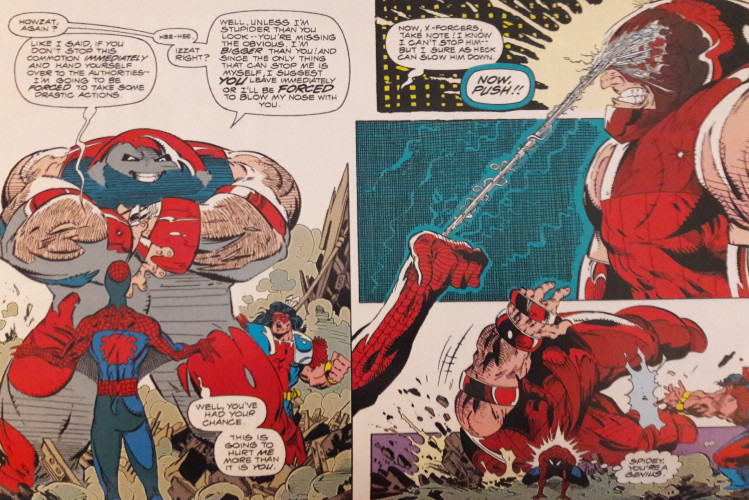
You, dear reader, with your eagle’s eyes, may have noticed that I mentioned issue #14 in my intro but listed issue #16 in the credits. Issue #15 is a standalone narrative starring the blue-bodied Beast, written and illustrated by Erik Larsen, who would take over the title following this issue. As I do not possess #15, I cannot comment on its quality. Should I ever procure it, I will be certain to do a “Crawling Back” installment on it.
For now, we have reached the end of McFarlane’s time on the title. This may be a nice retrospective glance back at previous posts as I provide commentary, particularly as there is not much meat to digest, even with the additional X-Force issue provided by Liefeld and Nicieza.

I know little about X-Force. I know they were formerly known as the New Mutants, a spinoff X-Men book created by Chris Claremont. I know Liefeld was a driving force (no pun intended) behind the title change. I know they’re a more militant branch of mutant heroes, made up of characters such as Cable, Feral, Domino, Shatterstar, and Warpath (the brother of then-deceased X-Man Thunderbird). I know they popped up in Deadpool’s second movie. That’s about it.
Despite a recent resurgence of interest in the X-Men, I’ve found myself feeling drawn thin by the copious number of X-books spawning out of the 80s and carrying into the 90s. I enjoy the pieces of Claremont’s run I’ve read, and I’ve picked up some X-Factor and Wolverine from the era, but I don’t plan on tracking down every appearance of every mutant (oh, my poor wallet) to get the full gist of Marvel’s mutant machinations. I say that to indicate I shouldn’t be surprised that these issues left me perplexed.
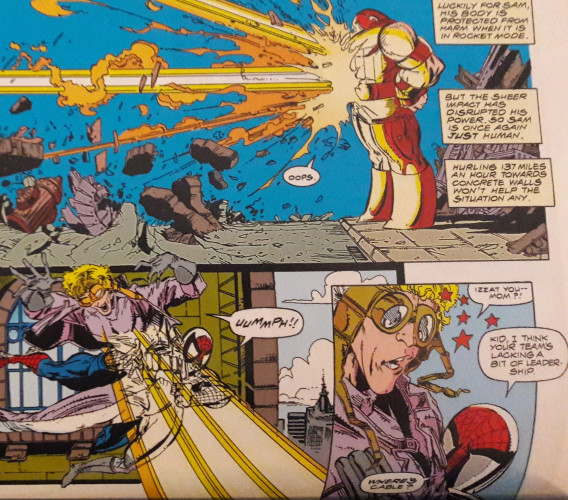
We begin in the middle–Spidey finds himself drawn into a conflict previously begun in X-Force #3 (an issue not included in the Complete Collection) between the titular team and foes Juggernaut and Black Tom Cassidy (half-brother of Professor Charles Xavier and cousin of Banshee, respectively). Google certainly helps piece some of the larger plot together, but this is a disappointing method of beginning McFarlane’s final issue (though not that he necessarily knew it would be his last at the time, which I will touch on in a bit). I’ve come to expect less and less from the book as a whole, but sucking Spidey into some random conflict with no context or buildup feels bizarre. A good section of a building has exploded by time Spidey’s on scene, and he’s left sifting through the rubble to piece the story together. By extension, so are we.
Not that context would necessarily save this two-parter. The whole narrative is one big fight scene, with the story jumping between Spidey and some X-Forcers facing off against Juggy on a street and some other X-Forcers fighting Black Tom Cassidy inside the World Trade Center. They fight. And yell some threats. And fight some more. Cannonball bounces off Juggernaut. Cable shoots Cassidy. Juggy gets his eye gouged by Shatterstar. It’s a funky back-and-forth which, in a literal sense, goes nowhere. We never leave the battleground, save for switching between the exterior and interior scenes.
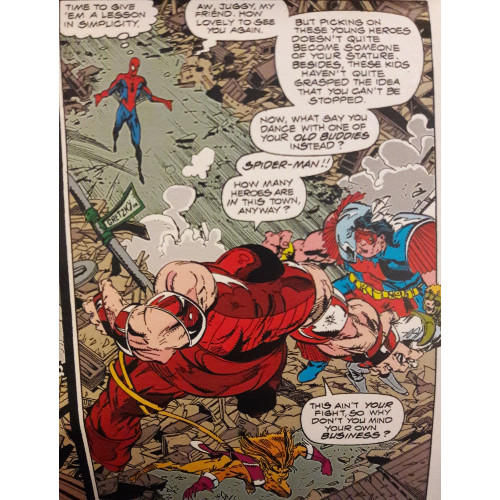
It’s just all very boring, to be blunt. I can’t even complain about McFarlane throwing in ham-fisted religious analogies or awkward commentary. There’s no mystery, like Spidey hunting a Wendigo with Wolverine or sneaking through the sewers after Morbius. It’s barely a story...just a wrap-up of a prior X-Force issue. Heck, I was at least hoping McFarlane would have Spidey or the Juggernaut comment on their shared history–like the time Spidey dipped Juggy in cement or teamed up with the X-Men to fight Juggy and Cassidy–but unless Spidey’s “How lovely to see you again” greeting to the Juggernaut is a ridiculously subtle easter egg, we get no such historical references (there is a somewhat deeper hint by Nicieza in the X-Force issue, but still, some elaboration would have been preferred). Beats me why the narrative encouraged the creators to title this two-parter “Sabotage,” but I can tell you it certainly feels like McFarlane’s work is crippled. Not that he had any running arcs to wrap up, but this was his last issue.
And all because of the Juggernaut’s eye.
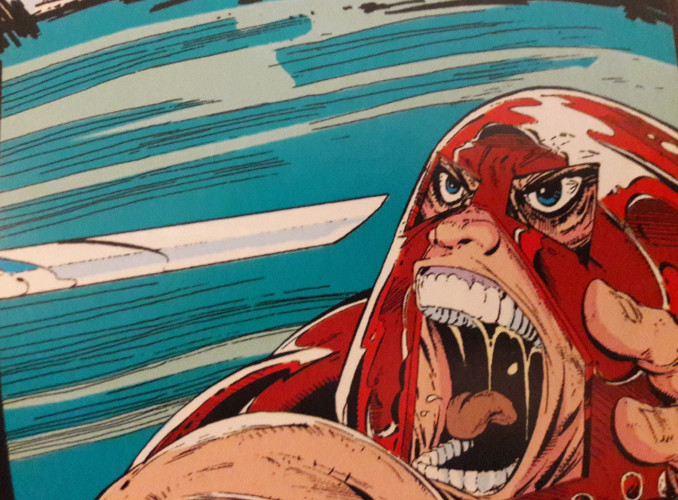
I’m not crying about McFarlane’s departure, mind. McFarlane chose to leave after Marvel censored his original art for Shatterstar’s attack on the red, rampaging ruffian, a much bloodier affair than it ended up being. It strikes me as utterly bizarre that a single panel in a two-part crossover with such little story, basically zero impact, spelled the end of McFarlane’s Marvel writing/illustrating career. Which is a shame, because the guy basically faded away into obscurity after that, never spawning any new characters or anything…ah, well.
I kid, I kid.
The story’s a letdown. Narratively? Boring. Artistically? Less component than McFarlane’s prior work. He draws a mean Juggernaut, but that’s really the only engaging aspect. Between him and Liefeld, our surroundings and the visual context of where we are is frustratingly limited, especially when switching between our heroes on the outside and heroes on the inside. Topping it all off, the issues were produced in a “Special Sideways” format, as the Spidey cover touts. This means you gotta hold the issues horizontally instead of vertically to read (see the cover image above for a good example), which is especially frustrating when you’re reading in trade format, thanks to some gutter loss.
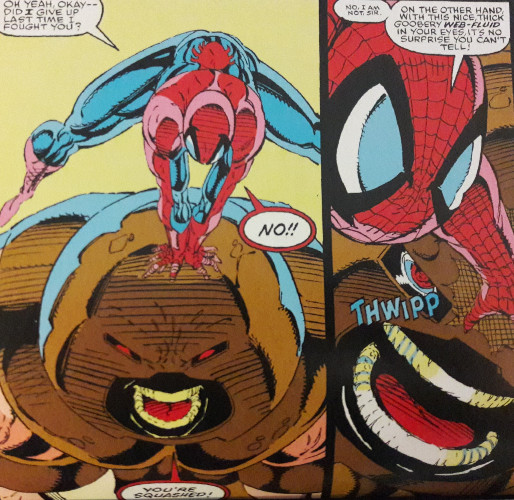
I’ve complained, liberally, of McFarlane’s work, but at the very least, I could always give him credit for trying. He took a lot of swings in the dark and generally smashed whatever remaining light bulbs dangled from the ceiling, but he struck the pinata once or twice (if you’re totally fine with accepting the metaphor of a man blindly swinging at a donkey filled with candy under less-than-optimal lighting conditions). His ideas were interesting. A more feral Lizard. A Hobgoblin possessed by a demon facing a Ghost Rider possessed by a demon. A murder mystery in Canada where the white-furred monster may or may not be the culprit. In execution, McFarlane could deliver artistically but generally found his imagination hindered by his prose. Awkward imagery, mediocre dialogue, a base understanding of certain characters. Artistic mastery limited by a lack in other talents.
And now, here, perhaps at the whims of other storytellers, McFarlane provides what he does best: detailed characters, even if his sets are less-than-stellar (though, to be fair, Liefeld’s probably the bigger culprit). The crossover feels forced, McFarlane utilized more for his artistic talents. Perhaps feeling a bit constrained, McFarlane tugged at his chains by ramming a sword through the Juggernaut’s eye. When told “No,” McFarlane simply lifted the chains off and departed. Why tug at the leash to see if it has more leeway when you can just cut it away and run free?
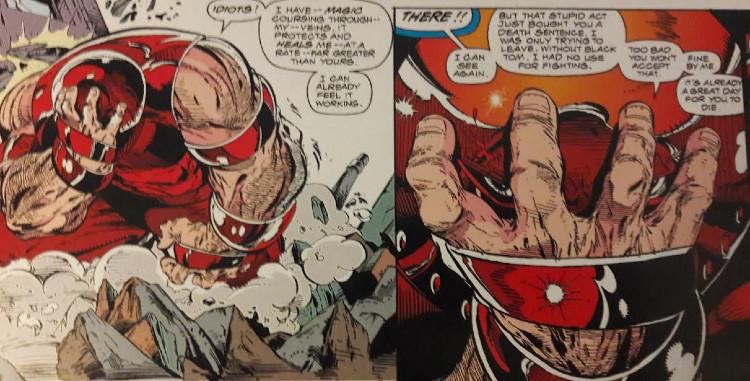
I feel left with a mixed bag. This was not the series I expected it to be. McFarlane found his writing chops once, in “Perceptions,” an oddity of a story across these 15 issues for representing the one time, to me, McFarlane’s words kept pace with his imagination. At the moment, I don’t intend on following this “Adjectiveless” Spider-Man title much further, save for an upcoming, Erik Larsen-crafted Sinister Six story and a few other crossover stories the title slithers into, such as “Maximum Carnage” and “The Clone Saga.” It’s a shame to witness a title with so much promise and potential, constructed upon the artistic merit of a truly talented individual, stray so quickly from its intended purpose, eventually being folded in as just another book, another ongoing chapter. What could have been more becomes less. The net comes up empty. The gator goes home hungry. We trawl no longer.